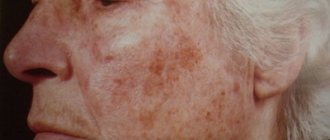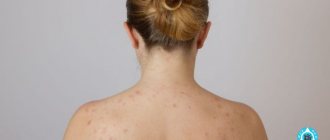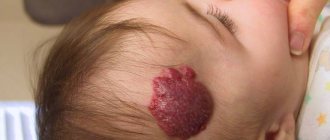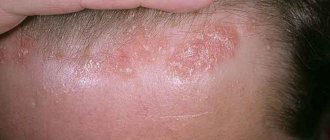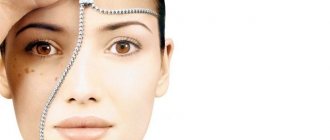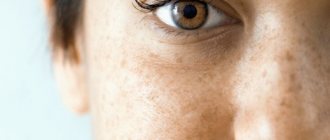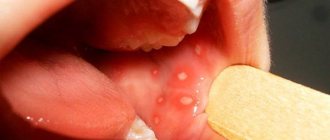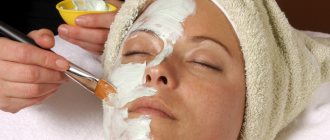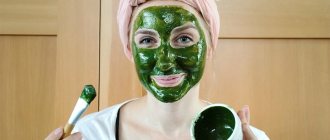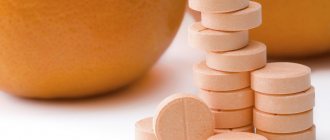Before starting the fight against hyperpigmentation, it is advisable to find out the reasons for the appearance of age spots on the face in women and men - the choice of the right strategy and tactics for combating age spots largely depends on this.
- What are pigment spots and how do they occur?
- Causes of age spots
- Pigment spots during pregnancy and taking OK
- Freckles and age spots
- Post-traumatic pigmentation
- How to eliminate age spots quickly, effectively and safely
- Contact a cosmetologist
- General principles of combating age spots
- Folk remedies for age spots
My video on YouTube about how to get rid of age spots:
What are age spots?
Pigment spots are places of various configurations and sizes of local accumulation on the skin of pigment melanin, which is responsible for the color of skin and hair in the human body. They can be a scattering of reddish large and small freckles or in the form of separate and even single brown spots of different shades.
The pattern of their correlation with a specific age is vague - they can appear in everyone, regardless of skin color, gender and age. Representatives of the first phototype, which includes gray-eyed and blue-eyed blondes, are especially susceptible to them. Tanning does not stick well to them, during which they are susceptible to sunburn during the shortest stay in the open sun.
For representatives of dark phototypes, the appearance of hyperpigmentation most often indicates a hormonal imbalance or an inflammatory process in the body the day before.
Dark spots on the lower extremities
Black spots on the legs can appear for various reasons; they can indicate illness (for example, spots form on the skin due to intestinal diseases) or indicate an allergic reaction to depilatory products or shower gels.
With this phenomenon, the body can warn a person about problems with veins and blood vessels, especially if purple spots appear on the skin of the lower extremities.
Dark spots on the buttocks may be evidence of a person's sedentary work, an allergic reaction to the synthetics from which underwear or cosmetics are made.
Dark spots on the skin between the legs may appear due to wearing uncomfortable clothes or using inappropriate cosmetics. Age-related changes also play an important role. They appear very often, and all this happens because it is in these areas that the skin is very sensitive. We will now try to figure out how to get rid of dark spots between the legs and on other parts of the body.
Causes of pigmentation
The shortest answer to questions about age spots and the reasons for their appearance can be considered genetic predisposition and solar exposure to ultraviolet rays on human skin. If it is almost impossible to fight the first, then the second aggressive impact can be minimized in various ways: from limiting this impact to the use of medications and cosmetics.
Ultraviolet rays and age spots
So friendly to all living things, UV rays are the first cause of age spots. They provoke their manifestation and intensification, determined by genetic predisposition.
Under the direct influence of UV rays on open areas of the skin at any time of the day, skin cells are damaged imperceptibly, which entails a natural protective reaction of the body, and melatocins come into play, producing a pigment that is unharmoniously distributed in places where the skin is damaged by ultraviolet radiation.
This fact clarifies the reason for the appearance of pigmentation on the protruding parts of the face (on the nose and cheekbones), the intensity of which, unfortunately, only increases with age.
Hormonal background
Hormonal changes in the body of women can also manifest themselves as unwanted pigmentation of different shades on the face. Especially above the upper lip - “pigmented mustache” and on the cheeks. Specifically this may be related to:
- with the period of pregnancy;
- with lactation period;
- with taking contraceptives.
After these physiological phenomena, as a rule, this kind of pigmentation disappears by itself. If this does not happen, you should seek advice and help first from an endocrinologist, and then from a cosmetologist, under whose supervision you will carry out the prescribed measures to eliminate lingering pigmentation.
Diseases and pigmentation
Unfortunately, the cause of increased pigmentation can be a number of diseases or dysfunctions in the functioning of the human body. These are liver problems, disruptions in the function of the endocrine system, as well as gynecological diseases.
In such cases, an effective fight for purity from pigmented skin problems will be an initial examination and appropriate therapy for the detected diseases, then or simultaneously, at the suggestion of qualified cosmetologists, you can resort to cosmetic measures.
Mechanical skin damage
Human skin is the most voluminous organ, it is a person’s protective barrier and often an indicator of his general condition. All damage to this epidermal barrier can and often is a condition for the development of pigment spots.
If we consider even microburns from solar radiation to be injuries to the epidermis, it is recommended not to do cosmetic procedures associated with even the slightest damage to the skin during the period of active sun, that is, in summer. This applies to chemical peels and dermabrasion, after which the cosmetologist must prescribe a regenerating line cream.
Unsafe mechanical damage includes home cleaning of the skin and removal of deep acne, the undesirable consequence of which can also be the formation of age spots.
Spots under the arms
While shaving, people notice that a dark formation has appeared under the armpit or under both. Pigmentation in the armpits is common.
The main reasons are as follows:
- Dark spots under the arms are the result of frequent shaving. The skin there is very delicate; with constant contact with the blade, it gets injured and ingrown hairs appear. All this contributes to coarsening.
- Failure to comply with personal hygiene rules and accumulated dirt leads to the appearance of spots.
- Fungal infections lead to candidiasis, erythrasma, and rubromycosis.
- Diseases of the liver and gallbladder lead to dark spots appearing under the armpits.
Types of pigmentation
Age spots may differ in appearance, color and size, but they are united by the same painful reaction to direct sunlight. Pigment spots have specific names that are well known to specialists.
Freckles (ephelids)
These are single-color fractional spots of approximately round configuration, with a diameter of 1 to 2 millimeters. They can appear on areas of the skin exposed to direct sunlight, especially in the spring - hence their Russian name. They can appear in varying degrees of intensity in many people, but the sun mainly loves blondes, brown-haired people and red-haired people.
Their seasonal activity is observed precisely in the spring, when everyone is drawn to the sun. The saturation of their color directly depends on the portion of ultraviolet radiation. By winter and until spring, during a period of almost complete absence of contact with it, freckles fade and even become completely invisible.
Lentigo (solar lentigo)
These are oval-shaped pigment spots larger (2-20 millimeters in diameter) and darker than freckles. They occur only on areas of skin exposed to the sun: the face, hands and décolleté.
Such spots, most often, are the same color, the persistent pigmentation of which does not depend on solar activity - they do not disappear on their own. They are usually called senile spots, because they are found in mature people in those places where freckles appeared in adolescence and young adulthood.
In old age, lentigines become larger and darker, and they are quite difficult to eliminate. From these spots you can understand which areas of the skin were affected in a person during a young period of his life.
For your information! The more careless a person is at a young age about periods of insolation, even for a minimal amount of time, the more intense in color and larger in size lentigines that are difficult to remove await him.
Birthmark (nevus)
Birthmarks appear on the skin even in infancy and continue to accompany a person throughout his life, increasing in number with age.
Melasma (chloasma)
A type of pigment spots that are large in size and blurred contours. They are also fueled by UV rays and are most often placed on the face. They have the ability to increase in quantity and size.
Most often, the nature of chloasma is associated with hormonal disorders or their temporary changes (pregnancy, lactation). Over time, melasma of this nature disappears on its own with the onset of hormonal balance.
Other diseases
- Moles – they are also called nevi or birthmarks. These are benign dark spots on the skin of the arms, legs, face, torso or other parts of the body. Nevus can be brown, beige, red, black and even purple. They usually have a regular round or oval shape (they are less common with irregular shape and uneven coloring, they can degenerate into oncology). They are flat and slightly raised above the skin. Usually there are up to 20 moles on the human body, but sometimes over 100 are found.
- Becker's nevus is a large dark spot on the skin with increased hair growth. The reasons for the appearance are unknown. A nevus never develops into a tumor; it most often occurs in teenage boys on the legs and lower torso. The defect grows slowly, the initial color is light brown, but during tanning it becomes very dark. It rises slightly above the skin and, when examined, looks like a large wart.
- Dubreuil's melanosis is flat nevi with a diameter of 2 to 6 centimeters. He has a high risk of degeneration into melanoma. The shape of the nevus is uneven, similar to a geographical map. The edges are torn. The color is uneven, there are bluish, purple or black inclusions. If you look closely, you will notice many small nodules.
- Acanthosis nigricans is a dermatological pathology in which the skin in the folds darkens and becomes rough. Appears on the neck, under the arms, in the groin area. The dermis in the folds darkens, gradually turning black. She becomes rough and rough. Papillomatosis may appear. The affected areas are slightly itchy, and moderate and aching pain is possible.
- Melanoma is a malignant neoplasm. Under favorable conditions, it degenerates from moles, lentigines and other spots. Melanoma has an irregular shape and uneven coloration. The tumor bleeds, hurts, burns. With timely treatment, doctors promise a favorable prognosis.
Photos of different spots and the name of the disease can be found on thematic resources. All information is provided for general development.
How to get rid of age spots
There are medical and folk, so to speak, ways of dealing with age spots , and here everything depends on the attitude of each individual to this problem. Some people even like light seasonal freckles, for example. But intensely colored and densely spaced, not fading even in the season of minimal insolation, rarely does anyone like it. Melasma, areas of dense pigmentation of the skin, “decorate” little, especially the face.
Phototherapy
This type of treatment aims to destroy clusters of melanocytes using high-intensity pulsed light. The course of such a treatment procedure is prescribed by the doctor, and it depends on the depth of the pigment and its intensity.
Selective laser
With such a laser, through an ultrashort pulse, the cells it finds with an increased melanin content are practically crushed into particles.
Chemical peeling
This course of peelings is successfully carried out by cosmetologists using glycolic acid, which has a renewing effect on the skin. Next, use the appropriate line of cosmetics that inhibit melanin production.
Basic treatment methods
There are several ways to help remove age spots. But in order to completely eliminate pigmentation, it is necessary to neutralize the factors that influenced the formation of the defect. To do this, it is advisable to be examined by the following specialists:
- Endocrinologist;
- Dermatologist;
- Gastroenterologist.
And if the reason is a malfunction of internal organs, a specialist will prescribe the correct treatment. Only then can you count on a lasting effect from all other procedures, which will be discussed below.
Cosmetology
Beauty salons offer various procedures to get rid of skin pigmentation. The most popular of them:
Dermabrasion. It is a polishing of the epidermis. By removing the top layer of skin, pronounced pigmentation disappears. This not only evens out the complexion, but also improves the overall condition of the skin.
Mesotherapy. It involves treating the epidermis with preparations containing amino acids and nucleotides. They are administered by injection, destroy pigmentation and whiten the skin. The healing effect is achieved through therapeutic agents and hardware effects on biologically active points.
Ultrasound peeling. It is done in several stages. First, the face is prepared for the procedure—remnants of impurities and decorative cosmetics are removed. Then a special cream or lotion is applied to the skin and treated with an ultrasound device. The skin becomes perfectly clean, but this manipulation can be carried out no more than once a year.
Phototherapy. This is the effect of light waves on the skin, which destroys cells with an increased concentration of melanin and smoothes out fine wrinkles. It does not give immediate results, so the skin is not stressed. Changes are observed after completing a full course of light therapy.
Chemical peeling. The essence of the method is treatment with preparations based on organic acids. Simultaneously with the destruction of pigments, it whitens the skin. After exfoliation of old cells, the regeneration process begins. The method is suitable for any age category.
Cryotherapy. Involves the use of liquid nitrogen. Rejuvenates and refreshes the skin, brightens problem areas. It is not used for acne and if pigmentation spreads to large areas of the epidermis - this is fraught with the appearance of scars.
Manipulations to eliminate skin defects should be carried out by a professional cosmetologist. Only then can you count on results and no side effects from the procedure.
Whitening creams
They can be purchased at a specialty store or pharmacy. Cosmetic products to combat increased pigmentation should contain the following components:
Ascorbic acid. Gently whitens the epidermis and improves its overall condition. Restores damaged cells.
Hydroxinone. Blocks melanin production and eliminates pigmentation. But it can only be used as prescribed by a doctor, because this substance causes allergies in some.
Beta carotene. Slows down the synthesis of the hormone responsible for pigmentation. Retinol. Destroys cells with high melanin content.
Arbutin and kojic acid. The properties are similar to hydroxinone, but do not cause allergic reactions.
Glycolic acid. Brightens facial skin.
And when choosing natural-based products, you should prefer those that contain bleaching agents - cucumber, lemon or aloe extract.
Whitening products should be used daily. But you should not exceed the recommended dosage, so as not to cause addiction or side effects. You need to consider your skin type. For oily skin, it is better to take a cream with a mattifying effect, and for dry skin, moisturizers with glycerin or hyaluronic acid.
Effective ingredients in anti-pigmentation cosmetics
We are talking about cosmetic formulas of whitening ingredients that reduce the synthesis of tyrosine, which precedes the formation of melanin:
- kojic acid - from AHA acids, characterized by exfoliating and whitening effects;
- arbutin is a natural component found in blackberries and bearberry. Together with kojic acid, arbutin enhances the whitening effect;
- ascorbic acid (vitamin C) has long been known as an antioxidant and active reducing agent that reduces melanin synthesis and activates collagen synthesis. Due to the undesirable ability of ascorbic acid to quickly degrade in cosmetics, the magnesium salt of L-ascorbic acid, which can be converted into vitamin C, is often used;
- Glabridin is an extract of licorice root. In addition to the whitening effect, it also has an anti-inflammatory effect.
Prevention of hyperpigmentation
The answer to this question is obvious - these are all kinds of activities and cosmetic products that can effectively protect against the all-penetrating UV rays of type A, which can affect a person and his skin through cloudiness and even through window glass. Less sun means darker pigment spots.
When choosing sunscreens, it is important that they contain filters against UVB and UVA rays, as well as caring components and antioxidants with a comfortable texture.
The general characteristic of sunscreens is not only long-term effective protection of the skin, but also a targeted fight against skin aging.
Lifestyle correction
Any treatment should begin with a review of lifestyle and elimination of provoking factors . The fight against pigmentation is no exception.
These few recommendations will help you make your treatment more successful:
- Completely give up bad habits.
- Be sure to walk in the fresh air so that your body (including your skin) receives enough oxygen.
- Review your epidermis care methods. If you have difficulties choosing cosmetics, consult a cosmetologist.
- Try to protect yourself from stress. If necessary, consult a neurologist or psychiatrist. The doctor will recommend sedatives or antidepressants that will help withstand psycho-emotional stress.
- Normalize your diet, giving preference to a healthy and balanced diet.
For pigmentation treatment to be successful, you need to give up coffee
Normalization of nutrition
To effectively get rid of pigmentation, doctors recommend fighting in several directions at once. One of them is proper diet. However, you should not place all your hopes solely on nutrition. Eliminating pigmentation only with a balanced menu will not work. But remember: without normalizing your diet, even the most effective methods of combating pigmentation can fail .
In nutrition, you must adhere to the following simple recommendations:
- There should be 4-5 meals during the day. The interval between meals is no more than 4 hours.
- It is important to establish a proper drinking regime and consume 1.5–2 liters of clean water.
- It is recommended to limit your intake of sugar and salt.
- Products that contribute to the appearance of pigmentation should be excluded from the diet. This category includes: Soy products. It promotes the accumulation of melanin in cells.
- Products containing beta-carotene. Excessive consumption of melons, corn, carrots, tomatoes, peaches and apricots can lead to stains even without the help of ultraviolet light.
- Saturated fats. They are part of animal foods: fatty meat, chicken skin, fatty dairy products, butter, some types of cheese.
- Products containing dyes. Such components can give color not only to food, but also to the skin, so it is better to avoid eating fast food and semi-finished products.
Products useful for pigmentation - table
| Essential vitamins | Benefits for the body | Product Name |
| Vitamin C |
|
|
| Vitamin A | Helps in the fight against pigmentation (with minor manifestations). Take only in small quantities! |
|
| Vitamin B12 |
|
|
| Vitamin PP |
|
|
| Vitamin B9 |
|
|
| Vitamin E |
|
|
Photo gallery: healthy products for skin
Bell pepper helps lighten skin
Milk helps to properly distribute melanin in tissues
Eggplants resist the harmful effects of ultraviolet radiation
Fresh greens promote cell renewal
Flaxseed oil gives skin tone and helps brighten it
How to deal with skin pigmentation at home
Numerous grandmother's recipes for whitening the skin of the face and hands are known, which help some users to some extent: homemade creams with herbal decoctions, serums, masks from fresh vegetables and fruits, as well as cosmetics (ointments, masks, cream, lotion) in a wide range assortment advertised and offered by domestic and foreign cosmetics manufacturers.
It’s good if, when choosing such cosmetics that can actually participate in the normalization of melanocytes, in lightening age spots and restoring the natural beauty of the skin, you know exactly the characteristics of your skin. Such a diagnosis should still be obtained from a cosmetologist, along with advice and recommendations on the use of cosmetics, especially in the fight and prevention of increased pigmentation.
Other popular folk remedies
The arsenal of folk remedies against age spots is not limited to masks alone. At home, you can prepare lotions, peelings, and decoctions with a similar effect.
Parsley
Parsley not only lightens age spots. It tightens the skin of the face, restores its tone, helps get rid of redness, swelling, and small expression wrinkles.
Parsley, chopped in a blender, can be used without additional ingredients. The resulting paste is simply applied to problem areas and washed off with water after 15–20 minutes.
Parsley is superior to many vegetables and fruits in its content of vitamins and microelements.
The simplest masks:
- A tablespoon of ground herbs, three - thick sour cream, 2-3 pinches of potato starch. Keep for 12–15 minutes.
- Chopped greens are ground with approximately an equal volume of cottage cheese, diluted with kefir or whey to the consistency of liquid sour cream. Apply for 20–30 minutes.
- A tablespoon of greens and a teaspoon of liquid honey. Action time: 8–10 minutes.
- Two tablespoons of greens, egg white whipped into a strong foam, a pinch of fine sea salt. Apply to face, lightly massaging. Use no more than twice a week.
Alcohol lotion gives a good effect. Three tablespoons of chopped herbs are poured into 500 ml of vodka and shaken. The mixture is infused for two weeks in a cool, dark place. Before use, strain the lotion.
You can freeze the green juice, infusion or decoction of parsley leaves and roots and wipe your face with the resulting ice cubes several times a day. Juice gives the best effect, but to obtain any noticeable volume, you will have to grow greens on an almost industrial scale. To prepare the infusion, the raw materials are poured with boiling water in a ratio of 1:5, the container is tightly closed, and the decoction is boiled for 15 minutes. If you don’t have fresh parsley, dried herbs, roots or seeds are quite suitable for preparing a decoction.
Ice cubes from parsley decoction not only brighten the skin of the face, but also have a tonic effect on it.
Video: whitening properties of parsley
Cucumber
A cucumber is more than 90% water. It will help not only whiten the skin, but also restore its firmness and elasticity. Homemade cucumber cosmetics are also useful for oily skin - these products tighten pores, reduce the activity of sebaceous glands, and help get rid of shine, pimples and blackheads.
The easiest way is to regularly wipe your face with cucumber juice or apply slices to problem areas. After this, it is recommended not to wash your face for as long as possible.
Many in childhood probably saw how mothers and grandmothers put cucumber circles on their faces
Cucumber lotion gives the fastest effect. But it is not suitable for dry, thin and sensitive skin. Five small fruits, without peeling, are grated on a coarse grater and poured with a glass of medical alcohol. Leave for 10 days and squeeze through several layers of gauze before use.
Homemade cucumber lotion is made with alcohol; this product is very irritating and dries out sensitive skin.
For masks, it is recommended to pre-cool cucumbers:
- Chopped pulp of a medium peeled vegetable, a teaspoon of honey. Keep for 15 minutes. Rinse with warm water, apply any nourishing cream.
- A tablespoon of oatmeal flour, one grated cucumber, whipped egg whites into a strong foam. Apply spotwise for 10–15 minutes.
- Dilute the parsley pulp with freshly squeezed cucumber juice until a creamy mass is obtained. Keep on face for 20–30 minutes.
Hot cucumber compresses additionally have a pronounced rejuvenating effect. But this procedure is contraindicated for any inflammation or mechanical damage to the face. Keep the compress on dry skin for no more than 15 minutes, on any other skin - half an hour. Water (100 ml) is heated to 40–45ºС, the juice of one cucumber and a teaspoon of glycerin are added. Soak a cloth with the resulting liquid and apply it to the face.
Video: cucumbers against age spots
Tar soap
Tar soap has a pronounced antiseptic effect and dries the skin well. When a course of procedures is carried out for 3–5 weeks, it begins to peel off, mainly cells from the superficial layers with hyperpigmentation die off. Laundry soap gives a similar result, but it will take more time. Contraindications: very dry, hypersensitive skin, any stage of pregnancy.
Tar soap causes intense peeling of the skin
The soap is rubbed on a fine grater and applied to problem areas. From above, the skin area is covered with gauze or a cotton pad folded in 2-3 layers, the entire structure is fixed with a plaster. You can remove the “bandage” after 2–3 hours. The procedure is carried out in the morning and evening. Then be sure to apply a nourishing cream so as not to provoke the premature appearance of wrinkles.
Apple vinegar
Only a natural product will benefit your skin. If you cannot prepare it yourself, carefully study the composition. There should be no preservatives, dyes, flavors and so on. Apple cider vinegar is essentially an analogue of a salon chemical peel. It dissolves the surface layers of the skin, and these are the cells with excess melanin. Contraindications - any damage to the skin of the face, acne, multiple pimples, herpes, the presence of any neoplasms of unknown etiology.
For home cosmetic procedures, choose only natural apple cider vinegar.
For peeling, 6% apple cider vinegar is diluted with water in a ratio of 2:1 for oily skin and 4:1 for normal skin. You need to get 200 ml of solution. 5-7 buds of cloves are added to it. The container is placed in a cool, dark place for 5 days, the liquid is shaken daily. Store the finished product in the refrigerator with a tightly closed lid. Moisten a cloth with the solution, press it tightly to the face, and repeat the procedure after 15 minutes. Then you need to wash your face with warm water and lightly massage your face with a wet terry towel. The duration of the course is no more than 10 procedures with an interval of 5 days (for oily skin) and 10–12 days (for normal skin).
You should not increase the concentration of apple cider vinegar in the peeling solution or carry out procedures more often, hoping for a more noticeable and faster effect, it is still an acid
Gommage is more gentle. A tablespoon of apple cider vinegar will require the same amount of liquid honey and a teaspoon of the finest sea salt. The mixture is kept on the skin for 2-3 minutes, then “rolled” off the face. After the procedure, you need to wash your face and apply regular cream.
The tonic is suitable for daily use. Apple cider vinegar is mixed with still mineral water, strong green tea or chamomile infusion in a ratio of 1:10, 1:5 or 1:1, respectively, for dry, normal and oily skin. Its effect is cumulative, you will have to be patient. Once every 2-3 days, you can wipe your face with a mixture of apple cider vinegar with lemon, onion, potato, and cucumber juice.
Video: apple cider vinegar against facial skin pigmentation
Hydrogen peroxide
In air, hydrogen peroxide oxidizes, releasing oxygen. Its molecules cannot exist in a free state, necessarily combining with something. When applied to the face, it is mainly pigments and sebum particles that “suffer”, which are literally “pushed” to the surface.
The maximum safe concentration of hydrogen peroxide is 3%. To avoid mistakes, it is better to purchase it at a pharmacy. Apply the product pointwise, using a cotton swab or disk, every 3-4 days. The duration of the course is no more than a month. Then a twice as long break is required. After the procedure, you cannot go outside for 6 hours.
Pharmacy hydrogen peroxide eliminates the risk of making a mistake with the concentration of the solution
Masks with peroxide are less aggressive, but you will have to wait longer for the effect:
- Grind a tablespoon of cottage cheese with thick sour cream, add 10 drops of peroxide. Keep on face for 20 minutes.
- Heat a tablespoon of burdock, sea buckthorn or castor oil, add 5 drops of wine or apple cider vinegar, peroxide. Apply pointwise and leave for 7-10 minutes.
- Dissolve a teaspoon of baking soda in 70 ml of water and add 3 ml of peroxide. Use as lotions. Keep for 10–15 minutes.
- A tablespoon of rice flour, a teaspoon of alcohol tincture or regular calendula infusion, 10 drops of peroxide. Apply the paste pointwise and hold for 10–15 minutes.
- A tablespoon of peroxide, a teaspoon of baby soap shavings, 4-5 drops of salicylic alcohol. For dry skin, add a teaspoon of vegetable oil. Keep on face for 5-7 minutes.
- Grind the pulp of half an avocado, add 5 ml of peroxide and a tablespoon of starch. Apply spotwise for 20–25 minutes.
- Pour cold green or chamomile tea over the grain bread crumb, let stand, squeeze a little. Add a teaspoon of sour cream and 10 drops of peroxide. Validity period: 15–20 minutes.
It is better to make masks with hydrogen peroxide at night - after the procedure you should not go outside for a long time
Video: how to get rid of age spots using hydrogen peroxide
Herbs
Plants (fresh or dry) are used at home to prepare decoctions, infusions and lotions. You will have to wait quite a long time for the result, but there is no risk of burning or otherwise damaging the skin. To combat pigmentation, the following are suitable:
- licorice;
- elecampane;
- yarrow;
- bearberry;
- birch leaves;
- pharmaceutical camomile;
- calendula;
- poppy;
- geranium;
- Linden blossom;
- lily petals;
- mint;
- sage;
- elderberry leaves;
- dandelion;
- fig leaves;
- arnica;
- comfrey.
Chamomile is a very common plant; you can prepare the raw materials yourself
Lotion Recipes:
- Chop two teaspoons of elecampane leaves and roots and add a glass of cold water. After an hour, bring to a boil, strain. Wipe your face 2-3 times a day.
- Pour hot water over fresh lily petals (about a handful) and boil for 15 minutes. Let it brew under a closed lid for 4-5 hours, strain.
- Pour boiling water over poppy petals and let steep for an hour. Strain before use.
- Pour three tablespoons of dandelion leaves and flowers into 0.5 liters of water and boil for 20 minutes.
Tinctures are used for lotions. Cotton pads moistened with liquid are applied to age spots for about an hour, not allowing them to dry:
- Juice of two lemons, mint infusion (two handfuls of dry leaves per 0.5 liters of boiling water). The product is suitable for both whitening and soothing the skin.
- A tablespoon of dried elderberry inflorescences, 300 ml of hot water. Leave for 12 hours. Strain, dilute with water in a 1:1 ratio.
- A tablespoon of yarrow leaves, 600 ml of water. Boil until its volume is reduced by half. Strain before use.
Lemon and mint tincture brightens and soothes skin
Available herbs, crushed into a paste, can be used as a mask. About 30 g of the mixture is poured with two tablespoons of boiling water, and a teaspoon of any vegetable oil is added. The mask is cooled and applied to the face for 20–25 minutes, covering it with a warm towel.
What else can you use?
Any foods high in vitamin C can be used as raw materials for masks. They will also become a very useful addition to the diet. These are, for example, citrus fruits, kiwi, black and red currants, broccoli, Brussels sprouts, wild garlic, bell peppers, onions, carrots, turnips. Grapefruit, pomegranate, and strawberry juice have the property of lightening the skin.
Black currants are superior to lemons in vitamin C content
You can add 2-3 drops of lemon, lavender, tea tree, vanilla, and mint essential oil to a regular store-bought cream. It is applied to the skin only when solar activity is minimal. The duration of the course is 20 days, then a break for 1.5–2 months.
An alternative to salon peeling is a mixture of chopped nuts with oatmeal in equal proportions and about half the volume of dry milk or powdered cream. Mineral water is added to it, bringing it to the consistency of sour cream. The product is applied to the skin using a sponge with light massage movements, washed off after 5 minutes. To enhance the effect, you can add grated pulp of a small green apple.
A procedure similar to salon almond peeling can be performed at home.
